Research on Properties of Ash and Slag Composite Cementitious Materials for Biomass Power Plants
Abstract
:1. Introduction
2. Experiment
2.1. Reagents and Materials
2.2. Sample Preparation
2.3. Testing Method
2.3.1. Fluidity Test
2.3.2. Setting Time
2.3.3. Mechanical Properties
2.3.4. XRD Analysis
2.3.5. SEM Analysis
2.3.6. Experimental Equipment and Soft Ware
3. Results and Discussion
3.1. Influence of Ash and Slag Content on the Setting Time of Pastes of Composite Cementitious Materials
3.2. Influence of the Ash and Slag Content on the Fluidity of the Pastes of Composite Cementitious Materials
3.3. Influence of Ash and Slag Content on the Mechanical Properties of Composite Cementitious Materials
3.4. Influence of Ash and Slag on the Hydration Minerals in the Composite Cementitious Material System
3.5. Influence of Ash and Slag on the Microstructure of Hydration Minerals in the Composite Cementitious Material System
4. Conclusions
- (1)
- The compressive strength of the P.O and SAC pastes gradually decreased with the rising ash and slag content. Compared with the reference cement, the 28 d compressive strength of the P.O pastes made with 30% biomass power plant ash and slag decreased by 27.8% and 15.0%, respectively, while that of the SAC pastes decreased by 27.5% and 35.0%, respectively. Nonetheless, the increase in the compressive strength was faster at the curing time of 7 d to 28 d, close to that of the control groups.
- (2)
- The addition of biomass power plant ash and slag could significantly prolong the setting time of P.O and SAC pastes, and the setting hindrance effect was more significant with the rising content. Using the 50% biomass power plant slag, the initial and final setting time of the P.O pastes grew by 28.8% and 25.2%, respectively, and that of the SAC pastes both grew by 50%.
- (3)
- After the addition of the biomass power plant ash and slag, the fluidity of the P.O and SAC pastes showed an upward trend and a decreasing-then-increasing trend as the ash and slag content increased, respectively.
- (4)
- According to the phase and microscopic analysis, the hydration of the P.O pastes was promoted after the addition of biomass power plant ash and slag, and the CH peaks in the products after 7 d of hydration were less intensive. The addition of ash and slag also promoted the clinker hydration of SAC pastes, resulting in an obvious increase in the AFt among the 7 d hydration products and a compact structure.
Author Contributions
Funding
Data Availability Statement
Acknowledgments
Conflicts of Interest
References
- Shi, Y.; Xue, C.; Qiu, Y.P. Analysis and Prospect of ash recycling technology in agricultural and forestry biomass direct fired power plants. J. Agric. Resour. Environ. 2019, 2, 13–17. [Google Scholar]
- Ren, C.Z.; Wang, W.L.; Mao, Y.P.; Yuan, Y.P.; Song, Z.L.; Sun, J.; Zhao, X.Q. Comparative life cycle assessment of sulfoaluminate clinker production derived from industrial solid wastes and conventional raw materials. J. Clean. Prod. 2017, 167, 1314–1324. [Google Scholar] [CrossRef]
- Zhou, N.; Fridley, D.; Khanna, N.Z.; Ke, J.; McNeil, M.; Levine, M. China’s energy and emissions outlook to 2050: Perspectives from bottom-up energy end-use model. Energy Policy 2013, 53, 51–62. [Google Scholar] [CrossRef]
- Shuai, C.Y.; Chen, X.; Wu, Y.; Zhang, Y.; Tan, Y. A three-step strategy for decoupling economic growth from carbon emission: Empirical evidences from 133 countries. Sci. Total Environ. 2018, 646, 524–543. [Google Scholar] [CrossRef] [PubMed]
- Demis, S.; Tapali, J.G.; Papadakis, V.G. An investigation of the effectiveness of the utilization of biomass ashes as pozzolanic materials. Constr. Build. Mater. 2014, 68, 291–300. [Google Scholar] [CrossRef]
- Raheem, A.A.; Adenuga, O.A. Wood Ash from Bread Bakery as Partial Replacement for Cement in Concrete. Int. J. Sustain. Constr. Eng. Technol. 2013, 4, 75–81. [Google Scholar]
- Nehring, V.; Silva, L.H.P.; de Maria, P.K.V.; de Paiva, F.F.G.; Tamashiro, J.R.; dos Santos, L.F.; Teixeira, S.R.; Kinoshita, A. Recycling of bamboo leaves and use as pozzolanic material to mitigate degradation of cementitious composites. Clean. Waste Syst. 2022, 3, 100053. [Google Scholar] [CrossRef]
- Zheng, X.; Liu, K.F.; Gao, S.Z.; Wang, F.Z.; Wu, Z.Z. Effect of pozzolanic reaction of zeolite on its internal curing performance in cement-based materials. J. Build. Eng. 2023, 63, 105503. [Google Scholar] [CrossRef]
- Georgopoulos, G.; Aspiotis, K.; Badogiannis, E.; Tsivilis, S.; Perraki, M. Influence of mineralogy and calcination temperature on the behavior of palygorskite clay as a pozzolanic supplementary cementitious material. Appl. Clay Sci. 2023, 232, 106797. [Google Scholar] [CrossRef]
- Swathi, V.; Asadi, S.S. An influence of pozzolanic materials with hybrid fibers on structural performance of concrete: A review. Mater. Proc. 2021, 43, 1956–1959. [Google Scholar] [CrossRef]
- Wang, H.Y.; Tsai, S.L.; Hung, C.C.; Jian, T.Y. Research on engineering properties of cement mortar adding stainless steel reduction slag and pozzolanic materials. Case Stud. Constr. Mater. 2022, 16, 1144. [Google Scholar] [CrossRef]
- Berenguer, R.; Lima, N.; Pinto, L.; Monteiro, E.; Povoas, Y.; Oliveira, R. Cement-based materials: Pozzolanic activities of mineral additions are compromised by the presence of reactive oxides. J. Build. Eng. 2021, 41, 102358. [Google Scholar] [CrossRef]
- Cheng, S.K.; Ge, K.Y.; Sun, T.; Shui, Z.H.; Chen, X.Y.; Lu, J.-X. Pozzolanic activity of mechanochemically and thermally activated coal-series kaolin in cement-based materials. Constr. Build. Mater. 2021, 299, 123972. [Google Scholar] [CrossRef]
- Kapeluszna, E.; Kotwica, Ł.; Malata, G.; Murzyn, P.; Nocuń-Wczelik, W. The effect of highly reactive pozzolanic material on the early hydration of alite—C3A—Gypsum synthetic cement systems. Constr. Build. Mater. 2020, 251, 118879. [Google Scholar] [CrossRef]
- da Silva, A.R.; de Paiva, F.F.G.; Silva, L.H.P.; dos Santos, L.F.; Tolosa, G.R.; Job, A.E.; Galvín, A.P.; López-Uceda, A.; Teixeira, S.R.; Kinoshita, A.; et al. Evaluation of pozzolanic activity and environmental assessment of cement composites with lubricating oil re-refining ash. Constr. Build. Mater. 2023, 376, 130980. [Google Scholar] [CrossRef]
- Zhang, H.R.; Ji, T.; Liu, H.; Su, S.L. Improving the sulfate resistance of recycled aggregate concrete (RAC) by using surface-treated aggregate with sulfoaluminate cement (SAC). Constr. Build. Mater. 2021, 297, 123535. [Google Scholar] [CrossRef]
- Xie, H.Z.; Ren, C.Z.; Zhao, B.F.; Liu, S.X.; Zhu, D.; Guan, H.B.; Xu, D.; Wang, J.W.; Yang, H.J. Characterization and use of biomass power plant ash in sulfoaluminate cementitious materials. Constr. Build. Mater. 2022, 325, 126667. [Google Scholar] [CrossRef]
- Olafusi, O.S.; Kupolati, W.K.; Sadiku, R.; Snyman, J.; Ndambuki, J.M. Characterization of corncob ash (CCA) as a pozzolanic material. Int. J. Civ. Eng. Technol. 2018, 9, 1016. [Google Scholar]
- Chen, R.; Congress, S.S.C.; Cai, G.; Duan, W.; Liu, S. Sustainable utilization of biomass waste-rice husk ash as a new solidified material of soil in geotechnical engineering: A review. Constr. Build. Mater. 2021, 292, 123219. [Google Scholar] [CrossRef]
- Kolesnikova, O.; Syrlybekkyzy, S.; Fediuk, R.; Yerzhanov, A.; Nadirov, R.; Utelbayeva, A.; Agabekova, A.; Latypova, M.; Chepelyan, L.; Volokitina, I.; et al. Thermodynamic Simulation of Environmental and Population Protection by Utilization of Technogenic Tailings of Enrichment. Materials 2022, 15, 6980. [Google Scholar] [CrossRef]
- Zhanikulov, N.N.; Khudyakova, T.M.; Taimasov, B.T.; Sarsenbayev, B.K.; Dauletiarov, M.S.; Kolesnikov, A.S.; Karshygayev, R.O. Receiving Portland Cement from Technogenic Raw Materials of South Kazakhstan. Eurasian Chem. Technol. J. 2019, 21, 333–340. [Google Scholar] [CrossRef]
- Kolesnikova, O.; Vasilyeva, N.; Kolesnikov, A.; Zolkin, A. Optimization of raw mix using technogenic waste to produce cement clinker. MIAB Min. Inf. Anal. Bull. 2022, 10, 103–115. [Google Scholar] [CrossRef]
- Ukrainczyk, N.; Vrbos, N.; Koenders, E.A.B. Reuse of woody biomass ash waste in cementitious materials. Chem. Biochem. Eng. Q. 2016, 30, 137–148. [Google Scholar] [CrossRef]
- da Silva Andrade Neto, J.; De la Torre, A.G.; Kirchheim, A.P. Effects of sulfates on the hydration of Portland cement—A review. Constr. Build. Mater. 2021, 279, 122428. [Google Scholar] [CrossRef]
- Lv, Q.F.; Wang, Z.S.; Gu, L.Y.; Chen, Y.; Shan, X.K. Effect of sodium sulfate on strength and microstructure of alkali-activated fly ash based geopolymer. J. Cent. South Univ. 2020, 27, 1691–1702. [Google Scholar] [CrossRef]
- Bonfim, W.B.; de Paula, H.M. Characterization of different biomass ashes as supplementary cementitious material to produce coating mortar. J. Clean. Prod. 2021, 291, 125869. [Google Scholar] [CrossRef]
- Hu, J.; Wang, K. Effect of coarse aggregate characteristics on concrete rheology. Constr. Build. Mater. 2011, 25, 1196–1204. [Google Scholar] [CrossRef]
- Feys, D.; Verhoeven, R.; Schutter, G.D. Why is fresh self-compacting concrete shear thickening? Cem. Concr. Res. 2009, 39, 510–523. [Google Scholar] [CrossRef]
- Thomas, B.S.; Yang, J.; Mo, K.H.; Abdalla, J.A.; Hawileh, R.A.; Ariyachandra, E. Biomass ashes from agricultural wastes as supplementary cementitious materials or aggregate replacement in cement/geopolymer concrete: A comprehensive review. J. Build. Eng. 2021, 10, 2332. [Google Scholar] [CrossRef]
- Yang, Z.; Huddleston, J.; Brown, H. Effects of wood ash on properties of concrete and flowable fill. J. Mater. Sci. Chem. Eng. 2016, 4, 101–114. [Google Scholar] [CrossRef]
- Ayub, M.; Othman, M.H.D.; Khan, I.U.; Hubadillah, S.K.; Kurniawan, T.A.; Ismail, A.F.; Rahman, M.A.; Jaafar, J. Promoting sustainable cleaner production paradigms in palm oil fuel ash as an eco-friendly cementitious material: A critical analysis. J. Clean. Prod. 2021, 295, 126296. [Google Scholar] [CrossRef]
- Hou, G.H.; Shen, X.D.; Xu, Z.Z. Study on the composition and properties of high silicate tricalcium Portland cement clinker. Acta Silic. Sin. 2014, 32, 5–10. [Google Scholar]
- Fang, P. A study of applying basic oxygen furnace slag to cement grouting repairing or strengthening material. Cem. Concr. Compos. 2015, 22, 12–25. [Google Scholar]
- Ye, Z.Y.; Wang, Q.Q. Preparation and properties of aluminosilicate solid waste cementitious material. Gold Sci. Technol. 2020, 28, 658–668. [Google Scholar]
- Zhu, J.; Yang, K.; Chen, Y.; Fan, G.; Zhang, L.; Guo, B.; Guan, X.; Zhao, R. Revealing the substitution preference of zinc in ordinary Portland cement clinker phases: A study from experiments and DFT calculations. J. Hazard. Mater. 2021, 409, 124504. [Google Scholar] [CrossRef]
- Zheng, K.R.; Chen, L.; Zhou, J. Pozzolanic reaction of glass powder and its influence on the composition of hydrated calcium silicate. Acta Silic. Sin. 2016, 44, 202–210. [Google Scholar]
- Wang, H.; Zhang, A.-l.; Zhang, L.-c.; Wang, Q.; Han, Y.; Liu, J.-z.; Gao, X.-j.; Shi, F.-t.; Lin, X.-y.; Feng, L.-y. Hydration process of rice husk ash cement paste and its corrosion resistance of embedded steel bar. J. Cent. South Univ. 2020, 27, 3464–3476. [Google Scholar] [CrossRef]
- Yao, Y.; Wang, W.; Ge, Z.; Ren, C.; Yao, X.; Wu, S. Hydration study and characteristic analysis of a sulfoaluminate high-performance cementitious material made with industrial solid wastes. Cem. Concr. Compos. 2020, 112, 103687. [Google Scholar] [CrossRef]
- Wu, K.; Shi, H.; Guo, X. Utilization of municipal solid waste incineration fly ash for sulfoaluminate cement clinker production. Waste Manag. 2011, 31, 2001–2008. [Google Scholar] [CrossRef]
- Wang, S. Quantitative kinetics of pozzolanic reactions in coal/cofired biomass fly ashes and calcium hydroxide (CH) mortars. Constr. Build. Mater. 2014, 51, 364–371. [Google Scholar] [CrossRef]
- Rashad, A.M. Investigation on high-volume fly ash pastes modified with micro-size metakaolin subjected to high temperatures. J. Cent. South Univ. 2020, 27, 231–241. [Google Scholar] [CrossRef]
- Kolesnikov, A.S.; Sapargaliyeva, B.O.; Bychkov, A.Y.; Alferyeva, Y.O.; Syrlybekkyzy, S.; Altybaeva, Z.K.; Nurshakhanova, L.K.; Seidaliyeva, L.K.; Suleimenova, B.S.; Zhidebayeva, A.E.; et al. Thermodynamic modeling of the formation of the main minerals of cement clinker and zinc fumes in the processing of toxic technogenic waste of the metallurgical industry. Rasayan J. Chem. 2022, 15, 2181–2187. [Google Scholar] [CrossRef]
- Taimasov, B.T.; Sarsenbayev, B.K.; Khudyakova, T.M.; Kolesnikov, A.S.; Zhanikulov, N.N. Development and testing of low-energy intensive technology of receiving sulfate-resistant and road Portland cement. Eurasian Chem. Technol. J. 2017, 19, 347–355. [Google Scholar] [CrossRef]
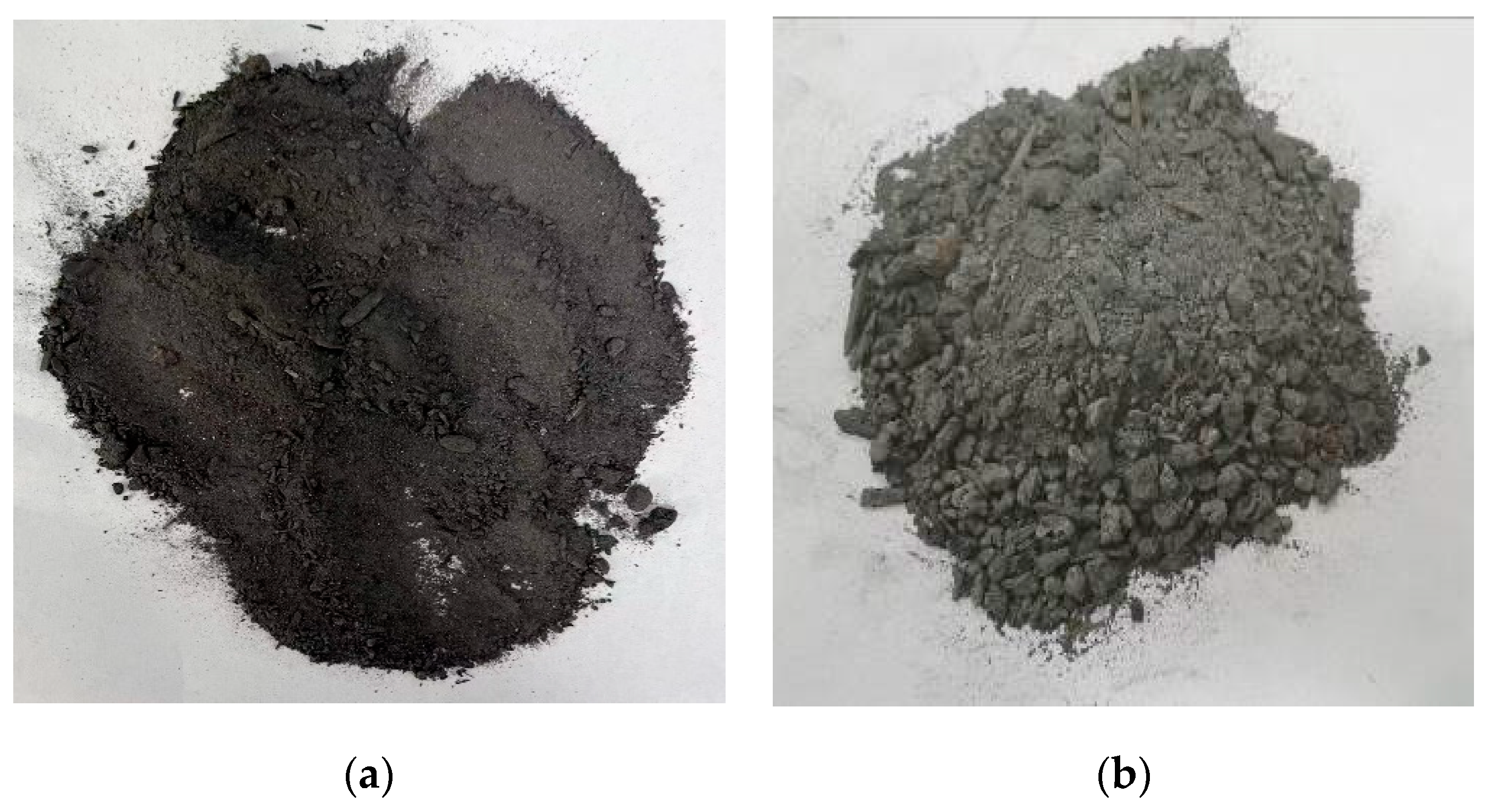
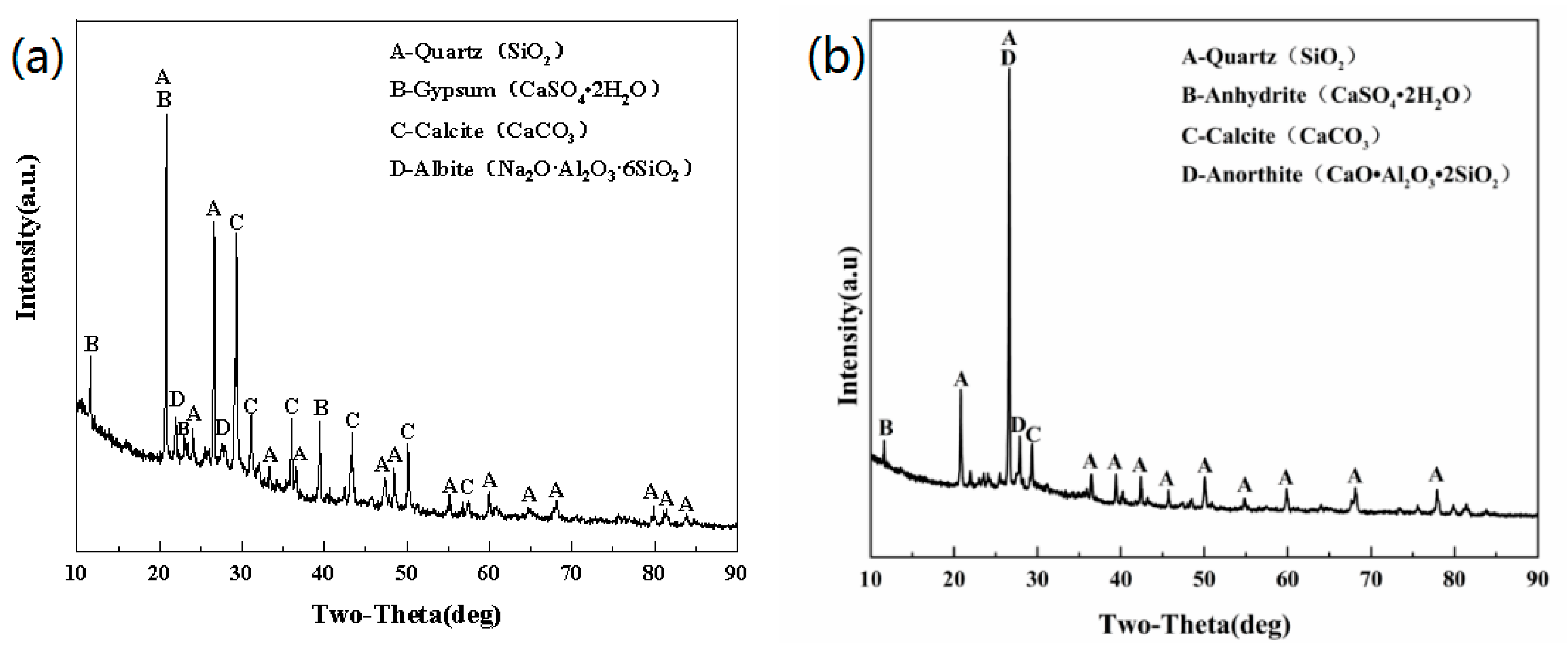

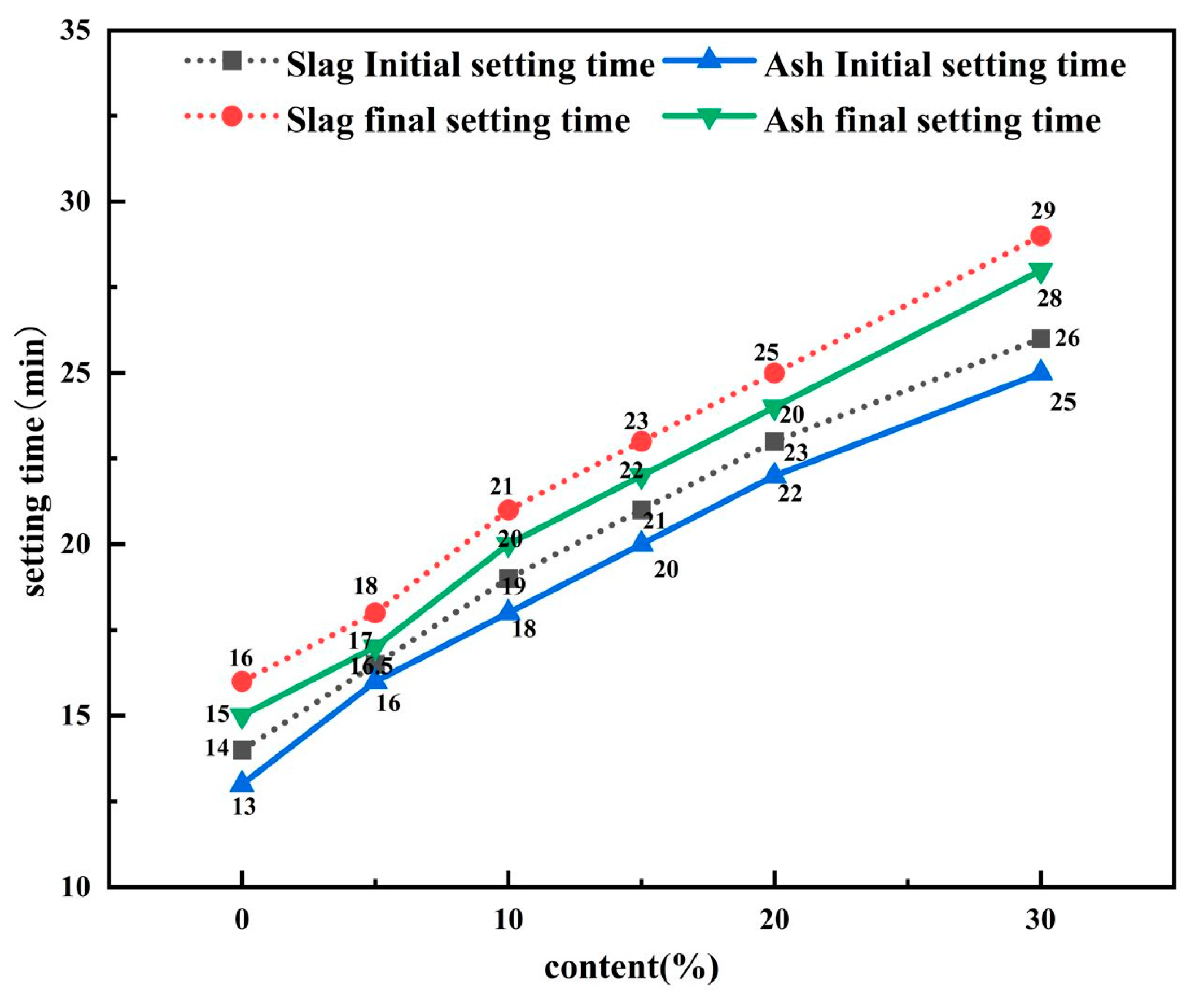

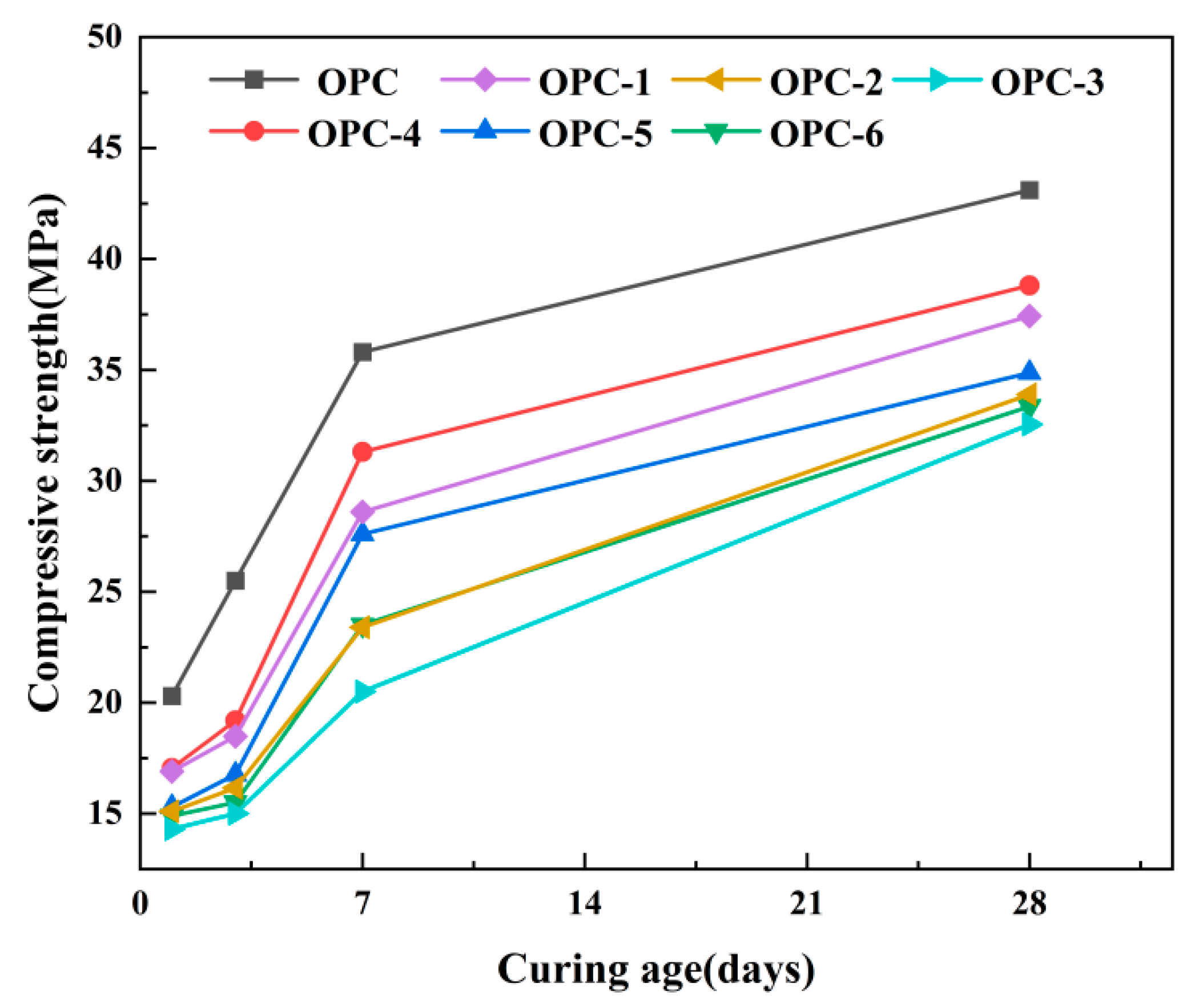
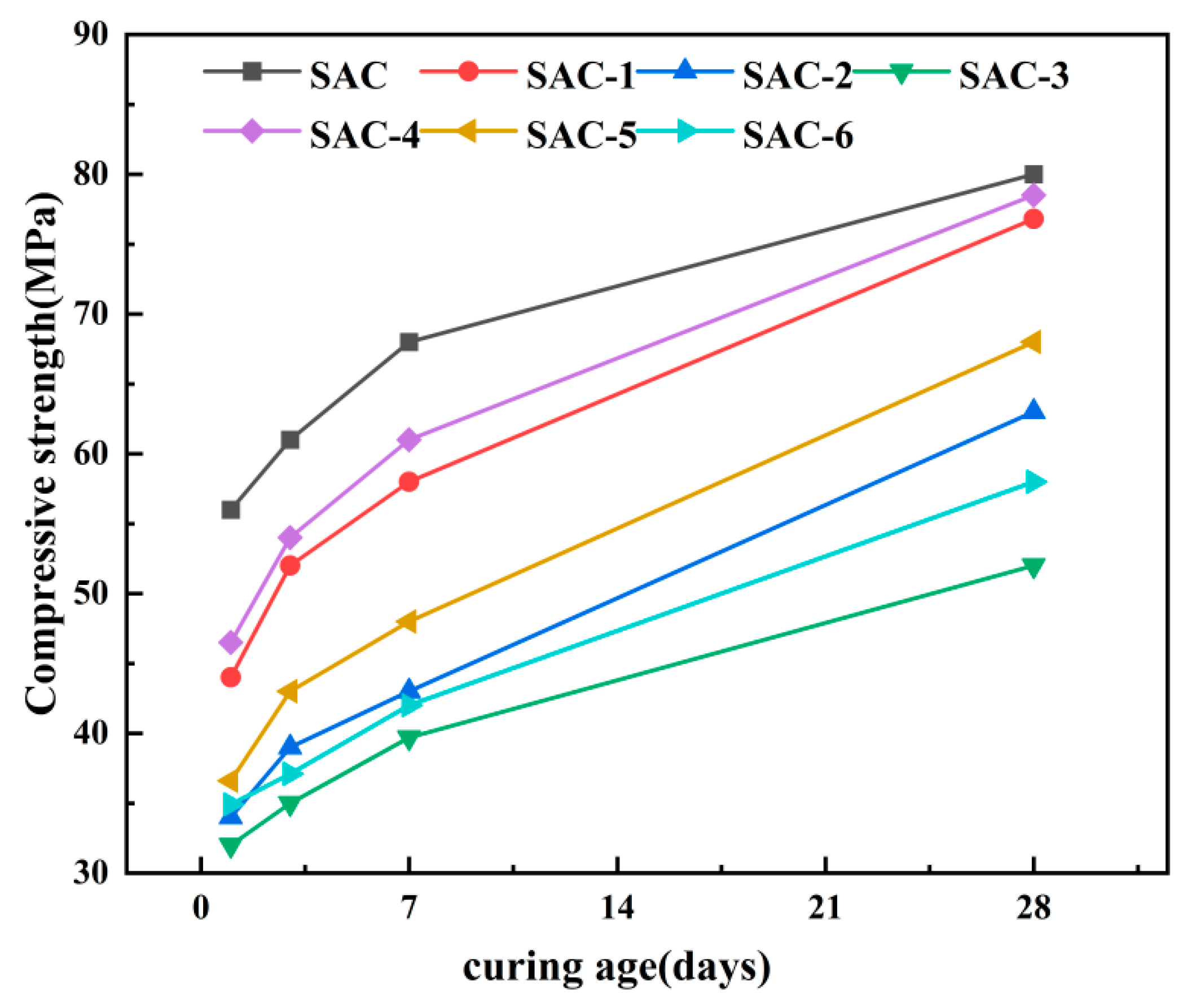

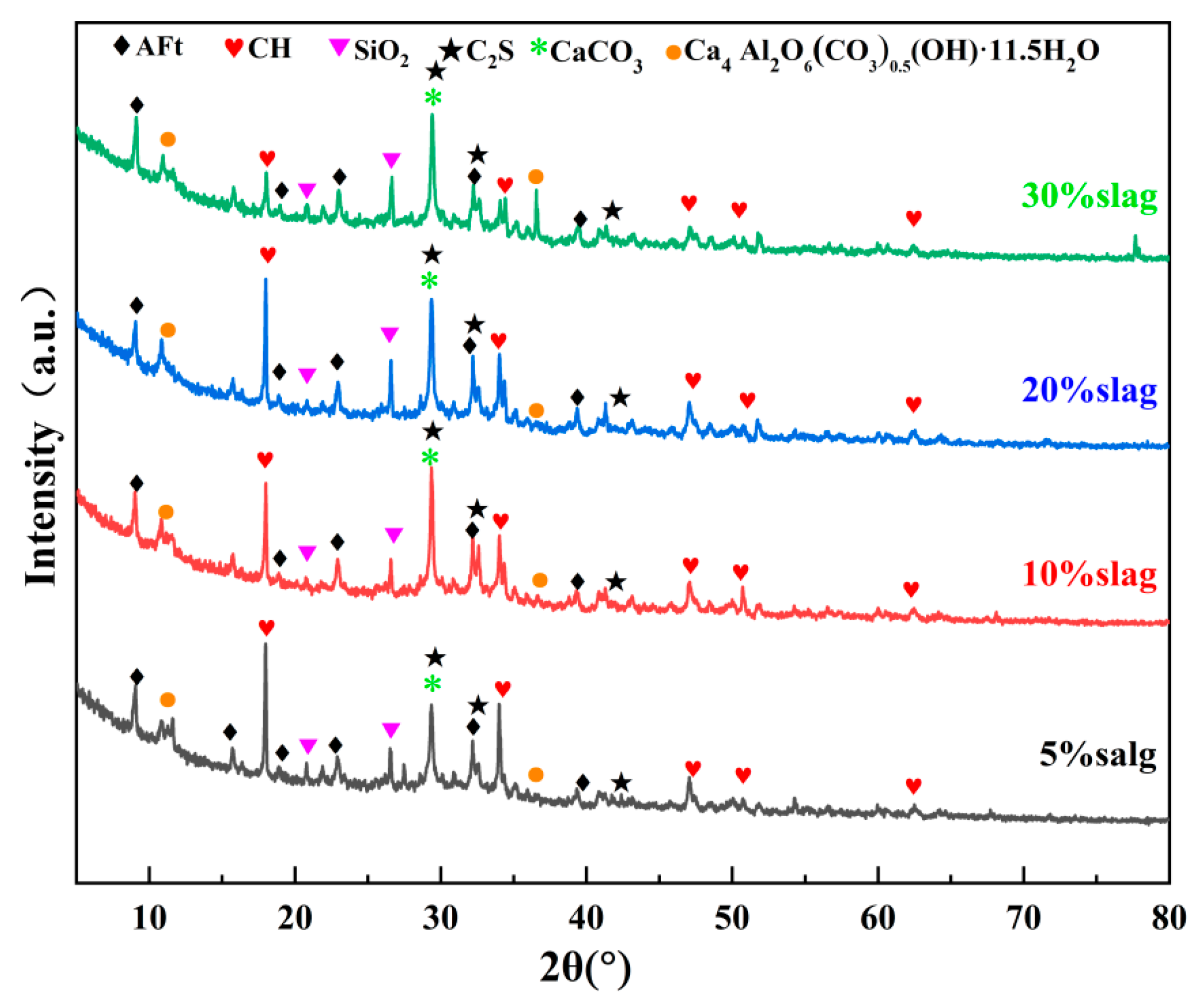
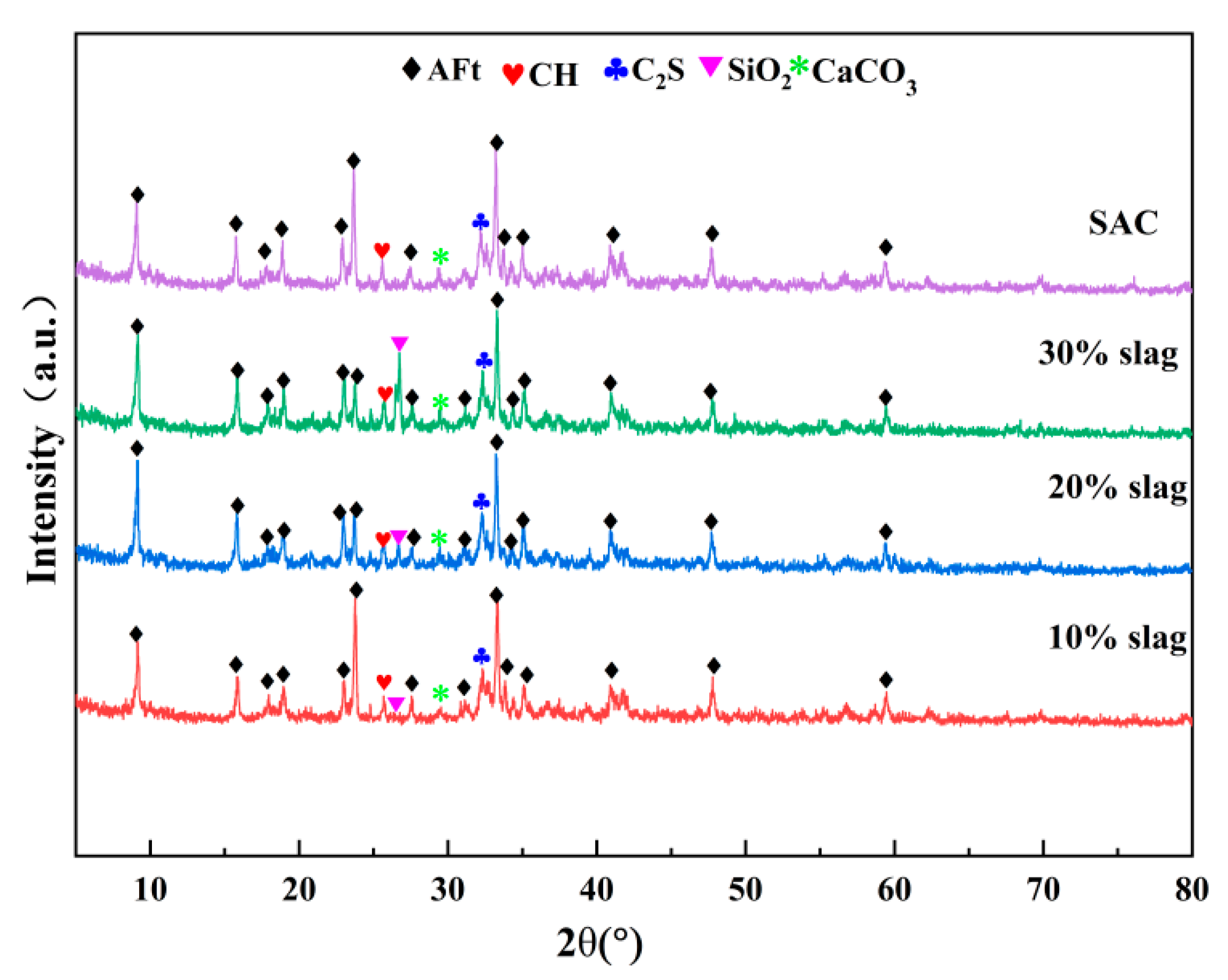

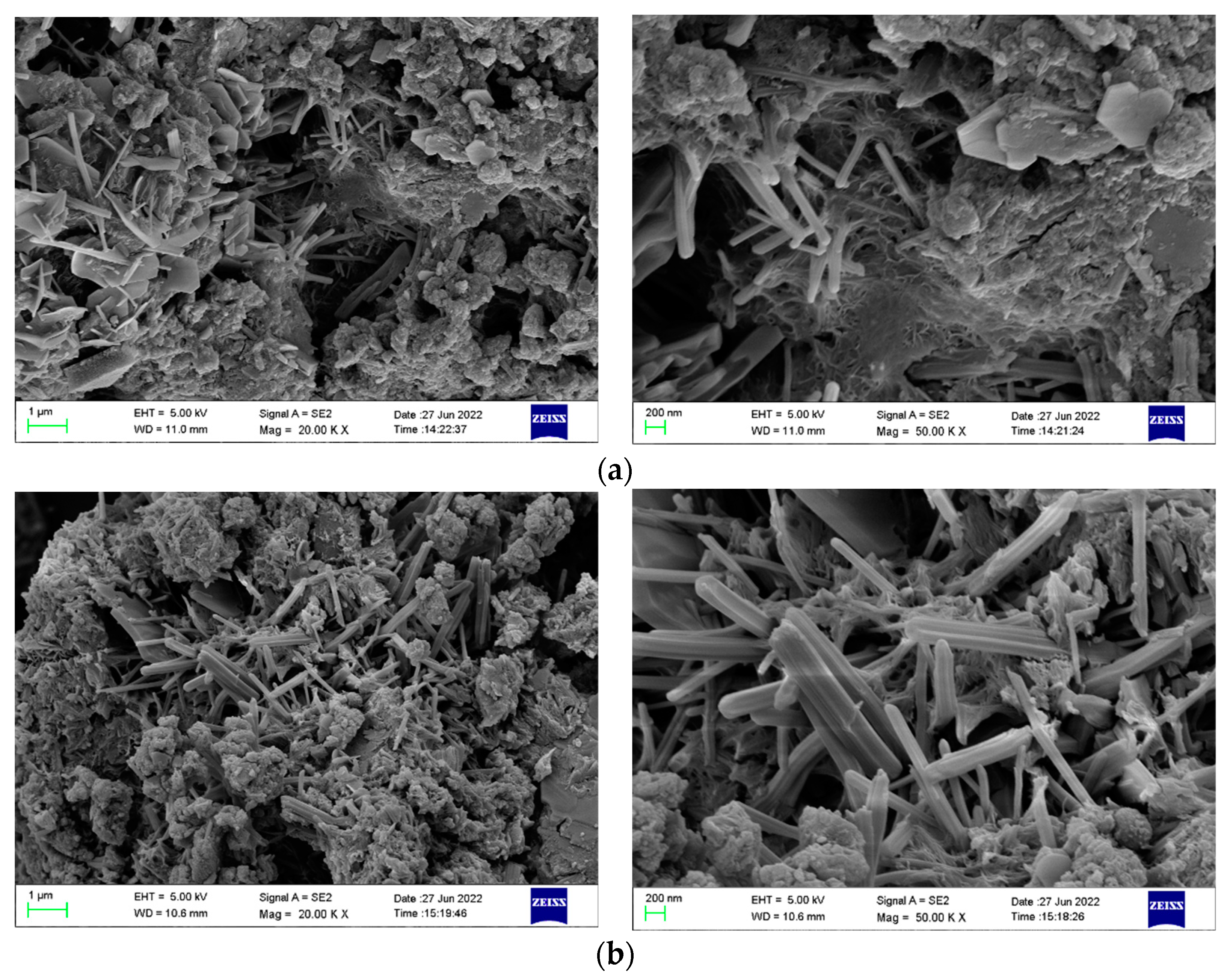
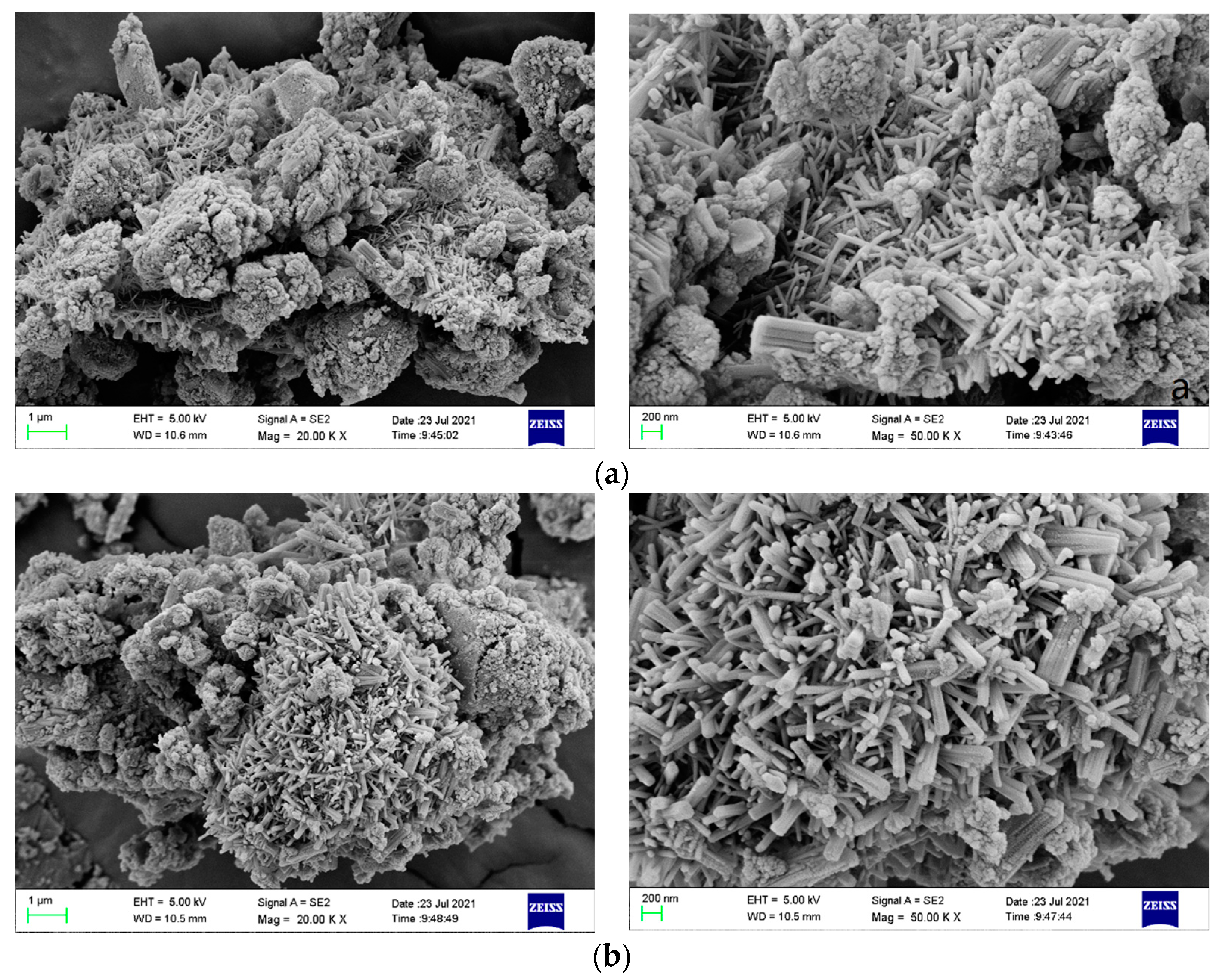
| Parameter | Material (wt%) | |
|---|---|---|
| BPPA | BPPS | |
| SiO2 | 34.25 | 44.84 |
| CaO | 24.42 | 11.95 |
| Al2O3 | 5.66 | 8.08 |
| Fe2O3 | 6.63 | 6.67 |
| Na2O | 2.00 | 1.31 |
| MgO | 2.01 | 1.84 |
| K2O | 4.41 | 6.49 |
| P2O5 | 0.96 | 1.03 |
| SO3 | 10.78 | 1.92 |
| Cl | 2.03 | 2.59 |
| TiO2 | 0.71 | 1.01 |
| MnO | 0.17 | 0.16 |
| a Loss on ignition | 6.00 | 12.12 |
| Composition | SiO2 | CaO | Al2O3 | Fe2O3 | Na2O | MgO | K2O | P2O5 | SO3 | TiO2 | LOI |
|---|---|---|---|---|---|---|---|---|---|---|---|
| SAC | 9.94 | 47.47 | 19.19 | 3.61 | - | 1.20 | 0.32 | 0.01 | 16.39 | 1.36 | 0.42 |
| P.O | 20.68 | 63.57 | 4.97 | 3.76 | 0.53 | 2.29 | 0.8 | - | 2.00 | - | 1.4 |
| Sample | Cement (wt%) | Ash (wt%) | Slag (wt%) | Water-Binder Ratio |
|---|---|---|---|---|
| OPC | 100 | 0 | 0.4 | |
| OPC-1 | 90 | 10 | 0.4 | |
| OPC-2 | 80 | 20 | 0.4 | |
| OPC-3 | 70 | 30 | 0.4 | |
| OPC-4 | 90 | 10 | 0.4 | |
| OPC-5 | 80 | 20 | 0.4 | |
| OPC-6 | 70 | 30 | 0.4 | |
| SAC | 100 | 0 | 0.4 | |
| SAC-1 | 90 | 10 | 0.28 | |
| SAC-2 | 80 | 20 | 0.28 | |
| SAC-3 | 70 | 30 | 0.28 | |
| SAC-4 | 90 | 10 | 0.28 | |
| SAC-5 | 80 | 20 | 0.28 | |
| SAC-6 | 70 | 30 | 0.28 |
| Number | Equipment/Soft Ware | Model | Manufacturer | Country |
|---|---|---|---|---|
| 1 | Fluidity tester | NLD-3 | Hebei Dahong Experimental Instrument Co., Ltd. | China |
| 2 | Automatic pressure measurement testing machine | DYH-300B | ShanDong LuDa Experiment instrument CO., Ltd. | China |
| 3 | X-ray fluorescence | D8-advance | USA Thermal Scientific CO., Ltd. | America |
| 4 | X-ray diffraction | D/max RB | Rigaku Denki Co., Ltd. | Japan |
| 5 | Automatic Vicat instrument | DL-AWK | Daolong Technology Co., Ltd. | China |
| 6 | Scanning electron microscopy | Hitachi S2300SEM | Hitachi Co., Ltd. | Japan |
| 7 | MDI jade | v6.5 | Accelrys Co., Ltd. | America |
Disclaimer/Publisher’s Note: The statements, opinions and data contained in all publications are solely those of the individual author(s) and contributor(s) and not of MDPI and/or the editor(s). MDPI and/or the editor(s) disclaim responsibility for any injury to people or property resulting from any ideas, methods, instructions or products referred to in the content. |
© 2023 by the authors. Licensee MDPI, Basel, Switzerland. This article is an open access article distributed under the terms and conditions of the Creative Commons Attribution (CC BY) license (https://creativecommons.org/licenses/by/4.0/).
Share and Cite
Zhang, Y.; Zhao, B.; Zhu, J.; Wang, Z.; Ren, C.; Xie, H.; Guan, H.; Zhu, D. Research on Properties of Ash and Slag Composite Cementitious Materials for Biomass Power Plants. Processes 2023, 11, 1627. https://doi.org/10.3390/pr11061627
Zhang Y, Zhao B, Zhu J, Wang Z, Ren C, Xie H, Guan H, Zhu D. Research on Properties of Ash and Slag Composite Cementitious Materials for Biomass Power Plants. Processes. 2023; 11(6):1627. https://doi.org/10.3390/pr11061627
Chicago/Turabian StyleZhang, Yanru, Baofeng Zhao, Jianjun Zhu, Zhenjiang Wang, Changzai Ren, Hongzhang Xie, Haibin Guan, and Di Zhu. 2023. "Research on Properties of Ash and Slag Composite Cementitious Materials for Biomass Power Plants" Processes 11, no. 6: 1627. https://doi.org/10.3390/pr11061627





